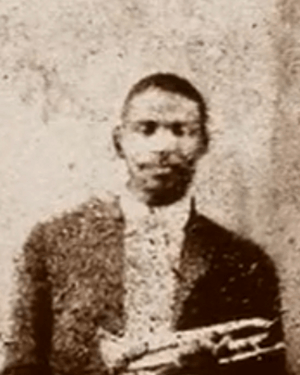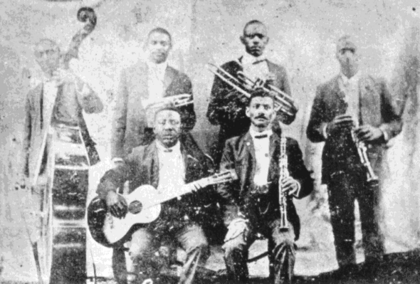Buddy Bolden facts for kids
Quick facts for kids
Charles Buddy Bolden
|
|
|---|---|
 |
|
| Background information | |
| Birth name | Charles Joseph Bolden |
| Born | September 6, 1877 New Orleans, Louisiana, U.S. |
| Died | November 4, 1931 (aged 54) Jackson, Louisiana, U.S. |
| Genres | |
| Occupation(s) | Musician |
| Instruments | Cornet |
| Years active | 1890's–1907 |
Charles Joseph "Buddy" Bolden (September 6, 1877 – November 4, 1931) was an African American cornetist who was regarded by contemporaries as a key figure in the development of a New Orleans style of ragtime music, or "jass", which later came to be known as jazz.
Contents
Childhood
When he was born, Bolden's father, Westmore Bolden, was working as a driver for William Walker, the former master of Buddy's grandfather Gustavus Bolden, who died in 1866. His mother, Alice (née Harris), was 18 when she married Westmore on August 14, 1873. Westmore Bolden was around 25 at the time, as records show that he was 19 in August 1866. When Buddy was six his father died, after which the boy lived with his mother and other family members. In records of the period the family name is variously spelled Bolen, Bolding, Boldan, and Bolden, thus complicating research. Buddy likely attended Fisk School in New Orleans, though evidence is circumstantial, as early records of this and other local schools are missing.
Musical career
Bolden was known as "King" Bolden (see Jazz royalty), and his band was at its peak in New Orleans from around 1900 to 1907. He was known for his loud sound and improvisational skills, and his style had an impact on younger musicians. Bolden's trombonist Willie Cornish, among others, recalled making phonograph cylinder recordings with the Bolden band, but none are known to survive.
Many early jazz musicians credited Bolden and his bandmates with having originated what came to be known as jazz, though the term was not in common musical use until after Bolden was musically active. At least one writer has labeled Bolden the father of jazz. He is credited with creating a looser, more improvised version of ragtime and adding blues; Bolden's band was said to be the first to have brass instruments play the blues. He was also said to have adapted ideas from gospel music heard in uptown African-American Baptist churches.
Instead of imitating other cornetists, Bolden played the music he heard "by ear" and adapted it to his horn. In doing so, he created an exciting and novel fusion of ragtime, black sacred music, marching-band music, and rural blues. He rearranged the typical New Orleans dance band of the time to better accommodate the blues: string instruments became the rhythm section, and the front-line instruments were clarinets, trombones, and Bolden's cornet. Bolden was known for his powerful, loud, "wide open" playing style. Joe "King" Oliver, Freddie Keppard, Bunk Johnson, and other early New Orleans jazz musicians were directly inspired by his playing.
One of the best known Bolden numbers is "Funky Butt" (later known as "Buddy Bolden's Blues"), which represents one of the earliest references to the concept of funk in popular music. Bolden's "Funky Butt" was, as Danny Barker once put it, a reference to the olfactory effect of an auditorium packed full of sweaty people "dancing close together and belly rubbing."
Bolden is also credited with the invention of the "Big Four," a key rhythmic innovation on the marching band beat, which gave embryonic jazz much more room for individual improvisation. As Wynton Marsalis explains, the big four (below) was the first syncopated bass drum pattern to deviate from the standard on-the-beat march. The second half of the Big Four is the pattern commonly known as the hambone rhythm developed from sub-Saharan African music traditions.
Physical and mental decline
Bolden had an episode of acute psychosis in 1907 at age 30. With the full diagnosis of dementia praecox (today called schizophrenia), he was admitted to the Louisiana State Insane Asylum at Jackson, a mental institution, where he spent the rest of his life. Recent research has suggested that Bolden may in fact have had pellagra, a vitamin deficiency common among poor and black groups in the population, and in 1907 sweeping through the South. His death on November 4, 1931, was caused by Cerebral arteriosclerosis according to the death certificate.
Further life and legend
While there is substantial first-hand oral history about Bolden, facts about his life continue to be lost amidst colorful myth. Stories about his being a barber by trade or that he published a scandal sheet called The Cricket have been repeated in print despite being debunked decades earlier.
Tributes to Bolden
Music
- Duke Ellington paid tribute to Bolden in his 1957 suite A Drum Is a Woman. The trumpet part was taken by Clark Terry.
- The Bolden band tune "Funky Butt", better known as "Buddy Bolden's Blues" since it was first recorded under that title by Jelly Roll Morton, alternatively titled "I Thought I Heard Buddy Bolden Say," has been covered by hundreds of artists, including Dr. John, on his album Goin' Back to New Orleans, and Hugh Laurie, on his album Let Them Talk.
- "Hey, Buddy Bolden" is a song on the album Nina Simone Sings Ellington.
- Wynton Marsalis speaks about Bolden in an introduction and performs "Buddy Bolden" on his album Live at the Village Vanguard.
- The Buddyprisen, or Buddy Award, is the prime award honoring Norwegian jazz musicians.
- Hop Along wrote "Buddy in the Parade" as a tribute to Bolden.
- Malachi Thompson recorded Buddy Bolden's Rag in 1995.
Personal life
Bolden married Hattie Oliver and had a child with her, born on the second of May, 1897. They named their son Charles Joseph Bolden, Jr.
His great-grandson Sammie "Big Sam" Williams is also a local New Orleans musician.
See also
 In Spanish: Buddy Bolden para niños
In Spanish: Buddy Bolden para niños



